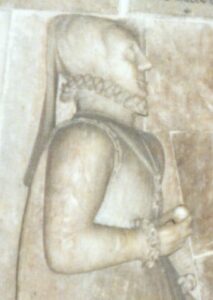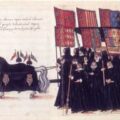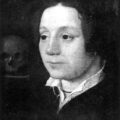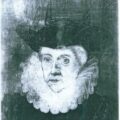
In Wednesday’s episode of “Elizabeth’s Women” on BBC Radio 4’s Book of the Week programme, the roles and duties of Elizabeth’s ladies were discussed, and today’s episode also focuses on Elizabeth’s ladies and the relationships the Queen had with them as she aged.
Witches
Tracy Borman writes of how Sir Walter Raleigh (or Ralegh) had concluded that Elizabeth’s ladies were “like witches, capable of doing great harm, but no good”, after he had attempted to use the Queen’s ladies as intermediaries to win back the Queen’s favour and failed miserably.
Although Elizabeth had always said that she did not want her ladies to meddle in politics, Borman writes of how this really was just a front and Elizabeth made use of her ladies to control her court. Members of the court were quick to realise that the Queen’s ladies had real power and influence and that they could be used to influence the Queen in their favour. One courtier even said:
“We worshipped no saints, but we prayed to ladies in the Queen’s time.”
Borman points out that the ladies’ role has, in the past, been overlooked, and that it was previously believed that they were not part of the political world, just the Queen’s private world. Borman says that this assumption “underestimates the political importance of personal relationships in her court” and that “Women may have been barred from holding political office, but as the stories of some of the female protagonists at court will show, they played an integral part in both the political and personal life of their sovereign.” These women had close contact with the Queen and also listened to her thoughts and feelings.
Elizabeth also made use of her ladies, and their extensive networks, to find out the gossip of court and what was going on. The information she received from them was so update that she often surprised people like Lord Burghley by knowing things that they really did not want her to know about!
Blanche Parry

Like Kat Ashley, Blanche Parry was one of Elizabeth I’s most trusted ladies as she had known the Queen since Elizabeth’s childhood. In “Elizabeth’s Women”, Borman writes of how Blanche Parry became Elizabeth’s unofficial secretary when she became Chief Gentlewoman of the Privy Chamber and her influence over Elizabeth was seen to be so strong that it became known at court that if you sent requests and paperwork to the Queen through Blanche then you had a higher chance of getting a positive result.
Blanche always said that Elizabeth was her number one priority and was obviously completely devoted to her mistress. The epitath on Blanche’s memorial is evidence of her devotion and the sacrifice that her service to the Queen really was:
“So that my tyme I thus dyd passe awaye
A maed in Courte and never no man’s wyffe
Sworn of the quene Ellsbeth’s bedd chamber allwaye
Wythe maeden quene a maede dyd ende my lyffe.”
The tomb that Blanche had left provision for was more evidence of her love for the Queen. On it, was depiction of the Queen in all her glory with the devoted Blanche kneeling beside her in a pose reminiscent of someone worshipping the Virgin Mary.
This devotion was not one-sided either. It is evident that the Queen was also devoted to Blanche, after all, she was the only link that Elizabeth had to her mother. Blanche could remember Anne Boleyn and could reminisce with Elizabeth about her childhood and her mother, she was Elizabeth’s friend and confidante. When Blanche died on 12th February 1590, Elizabeth was grief-stricken and immediately organised a funeral that was more befitting of a baroness than a queen’s lady. A good friend was gone and with her a precious link to the past.
Tracy Borman’s book also details Elizabeth’s relationship with other ladies, such as the Countess of Nottingham, Helena Gorges, the Countess of Warwick and Philadelphia Scrope, a Carey relative.
Wenches
As well as being friends, confidantes and spies, Elizabeth’s ladies could also be rather annoying to courtiers and to the Queen herself. Borman writes of how Sir Francis Knollys, whose chamber was next to that of Elizabeth’s ladies, got fed up with the way that they would “frisk and hey about in the next room, to his extreme disquite at nights, though he had often warned them of it”, and we know that Elizabeth did get tired of the behaviour of some of her younger ladies and would get angry at these “flouting wenches”.
Tracy Borman believes that Elizabeth’s anger was rooted in her belief that as she aged she was losing her grip on her court and its moral standards. Elizabeth would rage against her maids’ behaviour when she found out about secret marriages or affairs, and who can blame her?

One scandal involved the famous beauty Elizabeth Throckmorton, known as Bess, who was a Gentlewoman of the Privy Chamber. Sir Walter Raleigh was attracted to Bess’s beauty and started an affair with her which resulted in Bess becoming pregnant. The couple married in secret but Raleigh then became busy preparing for an expedition and on hearing whispers of his affair with Bess flatly denied their relationship. Abandoned by Raleigh, Bess cleverly hid her condition from her Royal mistress and managed to get a leave of absence at 8 months into her pregnancy to give birth away from the wagging tails of court. Bess even managed to return to service just 4 weeks after giving birth to her son Damerei as if nothing at all had happened.
Bess’s story does not have a happy ending though. Unfortunately for the maid, her secret got out and soon came to the ears of the Queen who felt betrayed by Bess who had married her royal favourite and broken the vows of service she had made to her mistress. Elizabeth was furious and threw both Bess and Raleigh into the Tower.
Borman writes of how Bess was unrepentant of her behaviour and spent her time in the Tower writing letters to her network of contact to try and get released, she even signed her letters “Elizabeth Raleigh”, which of course angered the Queen even more and although she forgave and released her former favourite Raleigh, Bess was kept imprisoned even when her son died of the plague. Bess was finally released two months after her son had died and it was made clear that she was no longer welcome at court.
The scandal of Bess Throckmorton was not the only scandal that rocked Elizabeth’s court and there were many in the later years of the Queen’s reign, including Anne Vavasour’s pregnancy by the Earl of Oxford and Lady Mary Howard’s suspected affair with the Earl of Essex. Elizabeth’s court morals did seem to be sliding and this both worried and angered the Queen who lashed out at her ladies.
Weakness
Not only was Elizabeth’s grip on her court weakening, she herself was also declining. Elizabeth took great steps to hide her decline from the court, using an even more elaborate ritual of dressing and thicker makeup.
Her “mask of youth” was made up of wigs that hid her grey hair, a mixture of white lead and vinegar (called ceruse) applied to her hands, neck and face, a beeswax and plant dye paste applied to give a red colour to her lips and kohl to line her eyes. Borman writes of how these “cosmetics” did more harm than good, with the white lead in the ceruse being extremely corrosive. But who can blame the Queen for wanting to retain her youth and always look her best, her image was incredibly important. Borman writes of how this mask of youth wasn’t just for vanity, Elizabeth knew that she needed to emphasise her importance, her authority and her divinely appointed status at all times, and she would only allow her most trusted ladies to see what was beneath her mask.
Borman writes of how, in January 1603, Elizabeth made the decision to move to Richmond Palace, a place to which she felt that she could “best trust her sickly old age”. It was here that Elizabeth seemed to abandon her younger ladies and put her trust in women like the Countess of Warwick, who had served her for over 40 years. As she was dying, in her delirium Elizabeth became tormented by ghosts and feelings of guilt, like the part she played in the execution of Mary Queen of Scots, and was deeply grieved when she found out about her friend the Countess of Nottingham’s (Katherine Carey) death. Some even say that it was this news that hastened Elizabeth’s own death.
On 23rd March 1603, Elizabeth’s ministers gathered around the dying Queen and it is said that when the Lord Admiral asked her if she wished James VI of Scotland to ber her heir the Queen drew a circle round her head to indicate a crown and to confirm that this was her wish. Dr Parry, Elizabeth’s chaplain reported that between 2 and 3 o’clock in the morning on the 24th March “Her Majesty departed this life, mildly, like a lamb, easily like a ripe apple from the tree”. Lady Scrope took the sapphire ring that James VI had given to her to use as a sign of the Queen’s death and dropped it out of the window to Sir Robert Carey, her brother, telling him to take it straight to James VI, who would become James I of England.
Elizabeth I’s funeral took place on 28th April 1603 at Westminster Abbey and it did indeed show how popular and loved this monarch was. Her loyal subjects crowded into the streets of the processional route and “divers of the beholders fell a weeping, especially women”. The funeral procession was made up of over a thousand, courtiers, nobles, ministers and bishops and nearly three hundred women, all dressed in black. Behind the Queen’s coffin were her faithful ladies, led by Helena Gorges, and, as Borman writes, these ladies “were as assiduous in serving their royal mistress in death as they had been in life.”
The life of one of England’s most popular and iconic monarchs was over and little did she know that she would still be fondly spoken of over 400 years after her death.
This article is based on episode 5 of BBC Radio 4’s Book of the Week on “Elizabeth’s Women”by Tracy Borman and on my reading of Chapters 14, 15 and 16 of the same book.











Fantastic site! Great blog too. I’l be checking back often!
Wonderful to see that Ms Borman and Radio 4 have finally given Mistress Blanche the credit she deserves in this final instalment of Elizabeth’s Women. The lack of sound biographical information in the past on this wonderful and fascinating figure of Elizabethan England has only just recently been remedied with the excellent work of Ruth E. Richardson. In addition to Ms Borman’s work, the 2007 biography by Richardson’s – ‘Mistress Blanche, Queen Elizabeth I’s Confidante’ – is well worth a look for anyone wanting to get beneath the surface of daily life at Elizabeth’s glittering Court.
Thanks, Miranda and Rochie, for the comments, I’m glad you enjoyed the article. Ruth Richardson’s book does sound interesting and I will definitely look into it when I come up for air from all the books that are piled up around me!
(I hear you on the coming up for air aspect!)
I am reading Borman’s book next, and I am looking forward to learning about all these other ladies and courtiers surrounding Elizabeth.
You wrote a well-informed post here and I thank you for your diligence. Well done!
If Sir Francis Knolly’s had a room next to a group of young guys, did he think they would be in there reading and talking quietly? Maybe he needed to remember what he was like back then LOL!
I’m currently reading the book and find it fascinating reading. If you’re a fan of Elizabeth I, I definitely recommend it!
that was so interesting